Ice Pick Acne Scars
According to the American Academy of Dermatology, acne is one of the most common skin conditions in the United States, affecting over 50 million Americans each year. Acne scars develop when inflammation related to acne disrupts collagen production during the natural healing process. One type of acne scar that is particularly difficult to treat is the ice pick scar, characterized by a deep and narrow indentation that can vary in depth depending on the severity of the previous acne lesion. Many patients feel frustrated and self-conscious about the appearance of ice pick scars, which often occur in highly visible areas of the face, such as the cheeks and forehead, and are challenging to conceal with makeup. Unfortunately, ice pick scars are often more difficult to address than the initial acne breakouts and remain permanent without intervention. Fortunately, Dr. Michele Green, a board-certified dermatologist in New York City, offers a variety of effective treatment options to minimize the appearance of ice pick scars.
The best treatment plan for ice-pick scars often combines various approaches tailored to your skin type, tone, and the severity of the acne scars. Dr. Green may utilize non-ablative laser treatments, such as Fraxel or eMatrix lasers to enhance skin texture or the VBeam laser for addressing post-inflammatory hyperpigmentation. Subcision with dermal fillers effectively breaks apart underlying scar tissue while replenishing lost volume in deeper scars. Other excellent options for ice-pick acne scar treatments include chemical peels, TCA cross, and microneedling. These cosmetic procedures typically require minimal downtime and consistently deliver stunning results. If you’re ready to treat your ice-pick scars and achieve clear, smooth, radiant skin, Dr. Green is here to assist you.
Dr. Michele Green is an internationally renowned, board-certified dermatologist with over twenty-five years of experience, offering some of the world’s most discerning individuals the finest non-invasive acne scar treatment options, including icepick scars. Dr. Green adopts a holistic approach to acne scar treatment, customizing each patient’s plan to integrate a combination of procedures best suited to their skin type, skin tone, and the types of acne scars present. She specializes in treatment options such as laser resurfacing, traditional and radiofrequency microneedling, chemical peels, TCA cross, dermabrasion, subcision with dermal fillers, and more. She is consistently recognized as one of New York City’s top dermatologists by Castle Connolly, New York Magazine, The New York Times, and Super Doctors for her commitment to her patients and expertise. When consulting with Dr. Green for acne scar treatment at her private boutique dermatology office in Manhattan’s Upper East Side neighborhood, she collaborates with you to help you achieve and maintain a healthy, clear, smooth complexion that lasts, allowing you to look and feel like the best version of yourself.
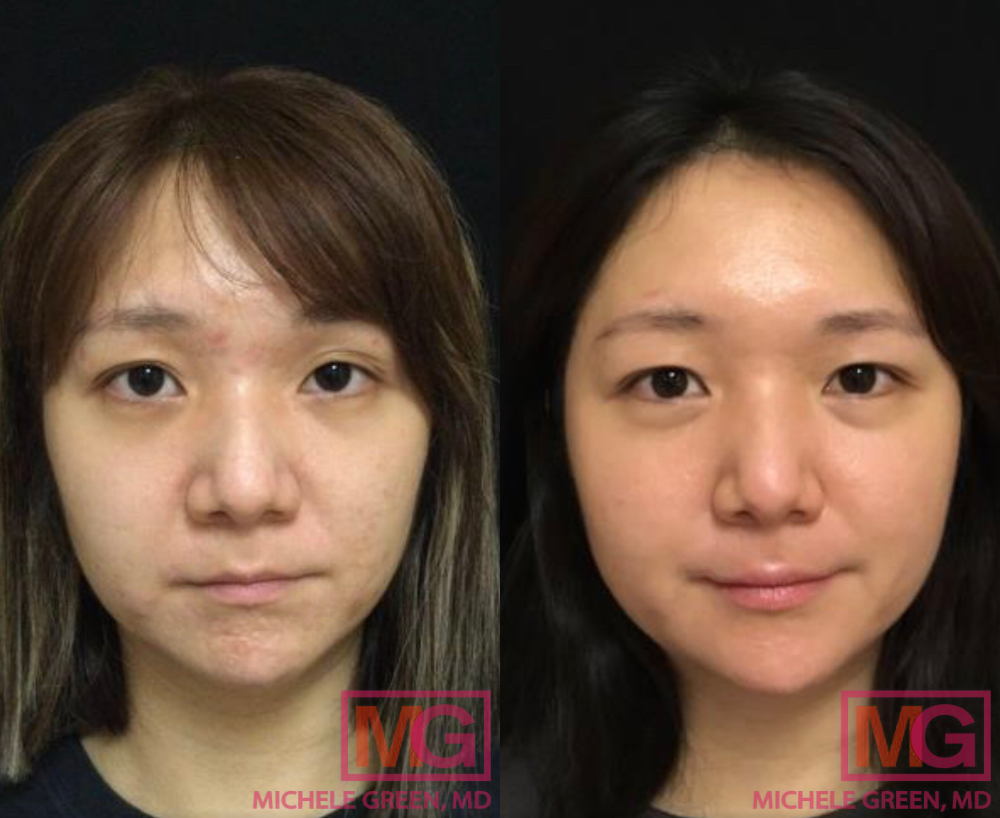
What are ice-pick acne scars?
Ice-pick acne scars are characterized by narrow, deep, sharp craters on the skin’s surface, which can develop following a severe acne infection. The inflammation associated with the infection prevents collagen from forming during the wound-healing process, leading to a depressed or atrophic scar. The term “ice-pick scar” comes from the resemblance of these indentations to those made by a narrow, sharp object like an ice pick. Ice-pick scars can vary in depth and size; however, they often extend deeper into the dermal layer than the original acne cyst or nodule, depending on the body’s healing response and the amount of new collagen generated. Since ice-pick scars frequently appear on highly visible areas of the face, such as the cheeks and forehead, many patients feel self-conscious about the deep scars and uneven skin texture typical of ice-pick and atrophic acne scars. Although ice-pick scars are challenging to treat, many effective options are available at Dr. Green’s private dermatology office in New York City.
Why do ice-pick scars form?
Ice-pick scars develop from untreated inflammatory acne breakouts, particularly deep cystic or nodular acne. When bacteria get trapped in pores clogged with oil and dead skin cells, inflammation and infection can arise, causing trauma to the surrounding skin and hindering the wound healing process. Consequently, insufficient collagen is produced, resulting in the formation of depressed acne scars like ice-pick scars. The deeper the initial infection, the deeper the ice-pick scar will be, making treatment more challenging. Picking, squeezing, or popping acne lesions can exacerbate or spread the infection, increasing the risk of permanent acne scars. Therefore, it’s crucial to seek treatment for active acne outbreaks as early as possible to prevent deep infection and potential scarring. An experienced, board-certified dermatologist, such as Dr. Michele Green in NYC, will collaborate with you to create a personalized acne treatment plan tailored to your specific skin condition, considering your skin type and medical and family history. Once the acne breakouts are managed, Dr. Green can develop a treatment plan for acne scars to diminish their appearance and achieve smoother skin texture.
Do ice-pick acne scars go away?
Ice-pick scars created by inflammatory acne lesions are typically permanent and will not go away on their own. Luckily, they can be treated with noninvasive cosmetic procedures by a board-certified dermatologist, such as Dr. Michele Green in NYC. A combination approach is often best when looking to eliminate the appearance of ice-pick scars, as both the indentation and the post-inflammatory hyperpigmentation must be addressed to restore the skin’s clarity. Popular treatment options for ice-pick acne scars include lasers like Fraxel, eMatrix, and VBeam, chemical peels, and traditional or radiofrequency microneedling. In some cases, when the scar is very deep, punch excision or punch grafting can be performed to remove the scar surgically. In order to guarantee safety, efficacy, and optimal results, it is always recommended to have acne scar treatments with an experienced board-certified dermatologist like Dr. Green in New York. Dr. Green customizes each patient’s acne scar treatment plan depending on their skin type, tone, and the types of acne scars present to ensure they get the best cosmetic outcome.
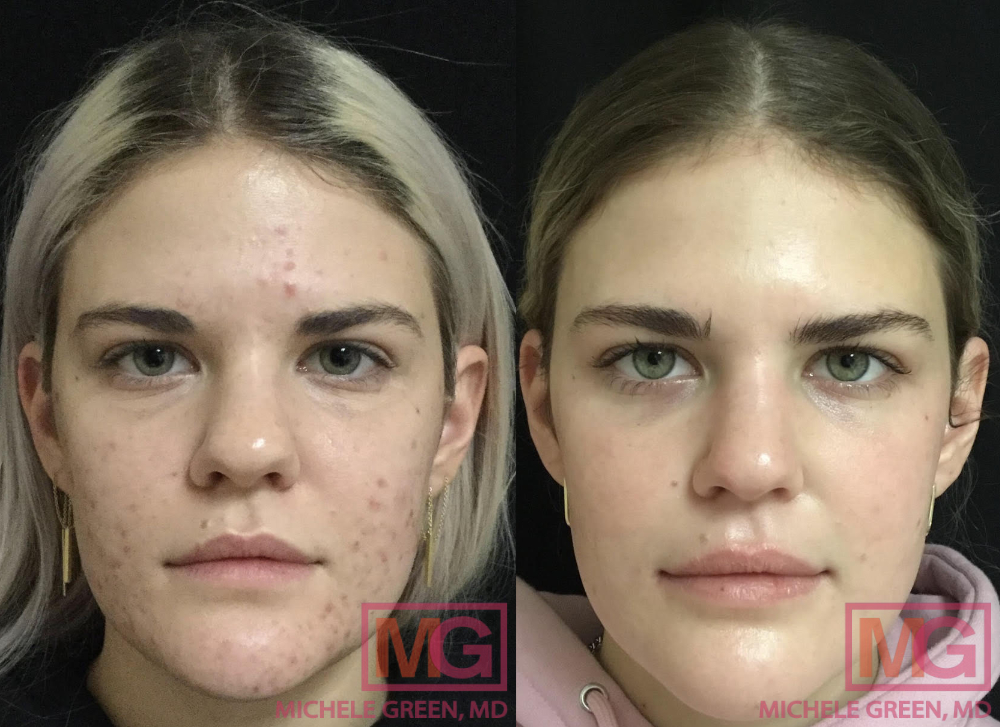
In-office treatment options for ice-pick scars
Laser therapy for ice-pick scar treatment
The Fraxel laser is one of the most popular options for acne scar treatment in Dr. Green’s office. It is often called the ‘magic eraser’ because of its ability to diminish the appearance of acne scars and improve skin texture. This laser uses fractionated energy to heat the inner layer of the dermis, stimulating collagen production, enhancing skin texture, and smoothing out ice-pick scars. Utilizing fractionated energy treats only a portion of the area while leaving the surrounding skin unharmed, which reduces downtime. The Fraxel laser features a 1550nm wavelength setting for addressing uneven texture, acne scars, fine lines, wrinkles, and pore size, along with a 1927nm wavelength setting for treating sun damage and pigmentation. When addressing ice-pick scars with the 1550nm wavelength setting, Dr. Green advises scheduling three to six treatment sessions, each spaced one month apart, to achieve the best cosmetic results.
The eMatrix laser is an impressive resurfacing tool that effectively reduces the visibility of ice-pick acne scars. This sublative laser harnesses radiofrequency energy to heat the skin’s inner layer, stimulating the body’s natural healing response and increasing collagen production. The procedure requires minimal downtime, with patients typically experiencing about 48 hours of mild redness and swelling post-treatment. The eMatrix laser is safe and effective for individuals of all skin types and tones, including those with darker skin, who may be more prone to unwanted side effects like hyperpigmentation associated with other laser treatment options. Dr. Green generally recommends five treatment sessions for ice-pick scars, with each session spaced 4-6 weeks apart.
The VBeam laser is the gold standard for erasing signs of post-inflammatory hyperpigmentation from old pimples or cysts. VBeam laser uses pulsed dye energy to target pigmented areas of the skin, which absorb the light and destroy the pigmentation while leaving the surrounding skin untouched. As a result, the VBeam laser is best used on red-pigmented acne scars. The VBeam laser can also be used on active acne breakouts to reduce the amount of acne-causing bacteria on the skin. There is no downtime associated with VBeam treatment, and the laser is equipped with a Dynamic Cooling Device that emits a burst of cool air before each laser pulse to enhance patient comfort during the treatment. Most patients need a short series of 4-6 VBeam laser treatments to achieve the best results.
Subcision with dermal fillers
Subcision is a procedure that breaks up the fibrous bands that tether the underlying tissue to the epidermis, or top layer of the skin. Once the bands are broken apart, the body is able to produce new collagen and create a smoother, more even skin texture in the treatment area. When subcision is paired with dermal fillers, the filler will then be injected into the area to restore lost volume from the acne scars and further stimulate new collagen production. Typically, Dr. Green will rely on hyaluronic acid fillers such as Juvederm and Restylane or liquid dermal fillers like Sculptra for acne scar treatment. Hyaluronic acid is a naturally occurring substance in the body that contributes to hydration and plumpness in the skin. Hyaluronic acid fillers provide immediate results after a single session and can last for six to twelve months, depending on the exact filler used. Sculptra is a unique dermal filler that is comprised of poly-L-lactic acid, a substance that promotes new collagen synthesis to smooth skin texture and restore lost volume. After an initial series of three or more Sculptra sessions, results can last for up to two years.
Chemical peels for acne scar treatment
A chemical peel is a noninvasive skin resurfacing treatment that improves skin tone, texture, and radiance by accelerating the rate of skin cell turnover to reveal healthy, new skin cells and stimulate new collagen production. Dr. Green typically utilizes TCA, or trichloroacetic acid, peels to chemo-exfoliate the skin and smooth the appearance of ice-pick acne scars. TCA peels can also help improve the appearance of fine lines, enlarged pores, and hyperpigmentation. Additionally, they are effective in unclogging pores and reducing active acne breakouts. The concentration of TCA used can vary for each patient, depending on the patient’s skin type and tone and the severity of ice-pick scars. Patients often require a series of TCA peels to see optimal results.
Patients experiencing post-inflammatory hyperpigmentation along with their ice-pick acne scars can also benefit from Mesopeels. Mesopeels are specially formulated chemical peels designed to fade unwanted pigmentation from the skin and reduce melanocyte activity. Mesopeels gently Patients experiencing post-inflammatory hyperpigmentation and ice-pick acne scars can benefit from Mesopeels. Mesopeels are specially formulated chemical peels designed to fade unwanted pigmentation and reduce melanocyte activity. These peels gently exfoliate the skin, removing dead, pigmented cells and revealing new, bright cells on the surface. Mesopeels involve no downtime and are safe and effective for all skin types and tones, including those with darker skin tones. Typically, a series of three to six Mesopeels is recommended for treating post-inflammatory hyperpigmentation from acne scars, exfoliating the skin to remove dead, pigmented cells, and revealing new, bright cells on the skin’s surface. These peels are associated with no downtime and are safe and effective for all skin types and tones, including patients with darker skin tones. Typically, a series of three to six Mesopeels is recommended for treating post-inflammatory hyperpigmentation from acne scars.
TCA cross to treat ice pick
The most effective chemical peel for treating ice pick scars involves using trichloroacetic acid, commonly known as TCA cross. This method utilizes a high concentration of trichloroacetic acid (70-100%) for the chemical reconstruction of skin scars, which is directly inserted into the indentations created by ice-pick scars. Typically, a tool like a toothpick is used to apply the chemical solution into the discrete ice-pick acne scars. After the solution is applied, a “frost” forms over the depression, triggering a controlled inflammatory response that leads to the production of new collagen in the treatment area. As new collagen forms, the depth of the scarring diminishes, resulting in a more even skin texture. Dr. Green recommends repeating the TCA Cross treatment every 6-8 weeks for optimal results. Patients with darker skin tones face a higher risk of hyperpigmentation as a side effect of the treatment. Therefore, Dr. Green may either apply the TCA Cross at a significantly lower concentration or suggest a different treatment option entirely.
Microneedling collagen induction therapy
Many patients in Dr. Green’s office ask, “Can microneedling help ice-pick scars?” The answer is yes! Microneedling, also known as collagen induction therapy, improves skin texture and tone while reducing the visibility of ice-pick acne scars. This procedure involves using a handheld device with tiny, surgical-grade needles to create micro-punctures in the epidermis. These controlled injuries trigger the body’s natural healing response, stimulating the production of the structural proteins collagen and elastin. As collagen and elastin are generated, they help fill in the deep ice-pick scars, enhancing the skin’s texture. Because microneedling also boosts the absorption of topical serums, Dr. Green can apply topical platelet-rich plasma (PRP) during the procedure to enhance the skin rejuvenation results of the treatment. PRP is a serum rich in epidermal growth factors and proteins, facilitating accelerated healing and tissue regeneration. It is derived from a sample of the patient’s blood, ensuring it is 100% safe to use in the procedure. Most patients need a series of microneedling treatments to achieve the best results, with each session spaced about 4-6 weeks apart.
Vivace radiofrequency microneedling for ice-pick scars
Vivace is a distinctive treatment option that merges the regenerative effects of traditional microneedling with radiofrequency (RF) energy to enhance collagen production. The microneedling component of the treatment involves creating micro-injuries in the epidermis using a handheld device with ultra-fine needles. Simultaneously, the treatment emits radiofrequency energy to heat the dermis, which aids in breaking up scar tissue and further prompts collagen production. This combination therapy is effective for tackling a wide variety of skin issues, including signs of aging, stretch marks, and acne scars, such as ice-pick scars, rolling scars, and boxcar scars. Most patients will need multiple treatment sessions to achieve their desired results. The specific number of sessions will depend on the initial severity of one’s acne scars; however, the average number of radiofrequency microneedling treatments for ice-pick acne scars is 4 to 6, with each session spaced about one month apart.
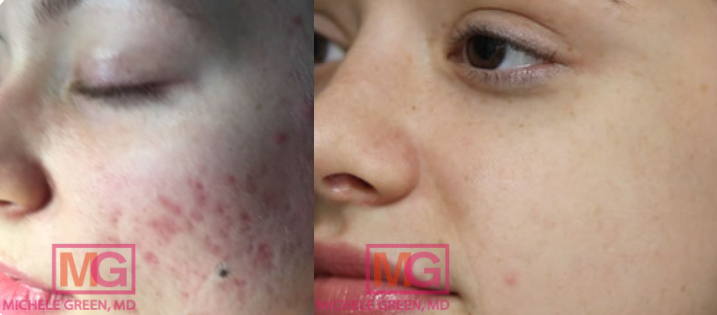
Microdermabrasion
Microdermabrasion is a non-invasive cosmetic procedure designed to exfoliate the skin and achieve a smoother texture. Traditional microdermabrasion employs a micro-crystal spray to remove the uppermost layers of dead and damaged skin cells. This method stimulates new collagen production and unveils a brighter, smoother complexion. Diamond microdermabrasion uses a diamond-tipped handpiece to sand the outer layer of skin gently. This treatment can effectively address mild textural acne scars or post-inflammatory hyperpigmentation. For moderate to severe acne scars and ice-pick scars, other treatment options that target deeper tissue layers, such as subcision with dermal fillers, TCA Cross, or laser skin resurfacing, are more effective.
Punch excision for treating ice-pick scars
When ice-pick scars are particularly deep, it may be best to consider a mild surgical treatment such as punch excision to remove the scar. During punch excision, a punch tool, commonly used for skin cancer biopsies, is employed to extract scar tissue. After the scar is removed, the wound left behind is closed with delicate sutures. Punch excision cannot be used to treat raised acne scars, such as keloids or hyperpigmented acne scars. Furthermore, punch excision cannot address any post-inflammatory hyperpigmentation linked to an acne scar. Since there is a risk of scarring and hyperpigmentation associated with any surgical procedure, Dr. Green only recommends punch excision for very deep ice-pick scars that do not respond to other treatment options.
Punch grafting to remove ice-pick scars
Punch grafting is a surgical treatment that utilizes a skin graft—typically taken from behind the ear—to close an icepick scar and achieve smoother skin. This technique is most effective for larger or deeper icepick scars located on less mobile areas of the face, such as the forehead. Due to the surgical nature of the procedure and the associated risks of further scarring or hyperpigmentation that may arise, Dr. Green recommends punch grafting only for very deep icepick scars.
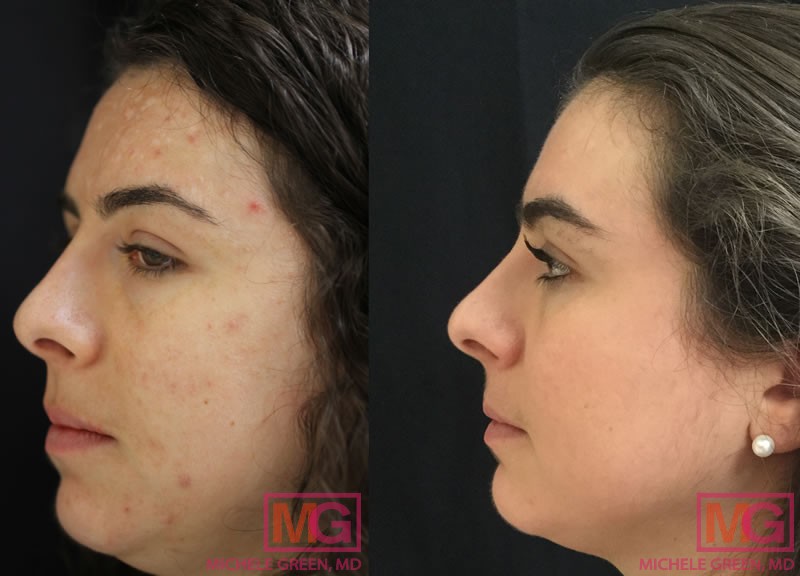
Which cream is best for ice-pick scars?
Over-the-counter and prescription creams are not effective on their own for treating ice-pick scars due to the depth of these scars; however, they can help maintain and enhance the benefits of in-office treatments. Additionally, it’s crucial to have a proper skincare routine tailored to your skin type and tone to prevent further acne breakouts. When consulting with Dr. Green at her private dermatology office in NYC, she will evaluate your skin concerns and acne scars to create a personalized skincare plan using both prescription and over-the-counter creams, aiming to help you achieve and maintain clear, smooth skin.
Retinols and retinoids are often the best topical products for reducing the appearance of acne scars, including ice-pick scars. These vitamin A derivatives accelerate skin cell turnover, sloughing off dead skin cells to reveal healthy, new cells at the skin’s surface. They also stimulate collagen production, helping to create a more even skin texture. Retinols are available over the counter in various serums and creams. Dr. Green’s proprietary skincare line, MGSKINLABs, offers the Essential Antioxidant Infusion, which is packed with retinol, vitamins, and other nutrients to exfoliate and nourish the skin. Retinoids, which are stronger than retinol, can only be obtained through a prescription from a board-certified dermatologist. Commonly prescribed retinoids include Retin-A and tretinoin. When using a retinol or retinoid, it is crucial to practice proper sun protection by wearing broad-spectrum sunscreen and sun-protective clothing, as these products increase the skin’s sensitivity to sunlight.
Skincare products featuring active, targeted ingredients can be excellent complements to in-office treatments aimed at reducing the appearance of ice-pick scars. Vitamin C serves as a powerful antioxidant that boosts the skin cell turnover rate, removing dead pigmented cells to reveal healthy, bright cells on the skin’s surface. The Vita-C serum from MGSKINLABS provides a high concentration of vitamin C to enhance skin texture and radiance. Products containing alpha hydroxy acids (AHAs) or beta hydroxy acids (BHAs) can also help improve the look of ice-pick acne scars. AHAs like glycolic acid and BHAs like salicylic acid gently exfoliate the skin, effectively enhancing skin texture and tone.
Sunscreen is an essential part of any skincare routine, especially when undergoing in-office treatments for ice-pick scars. UV rays can damage collagen and elastin fibers, leading to increased skin laxity and a worsening appearance of ice-pick acne scars. Many treatment options, including resurfacing lasers and chemical peels, can also heighten the skin’s photosensitivity. Using a broad-spectrum sunscreen with an SPF of 50 is crucial for protecting the skin from both UVA and UVB rays. The Hydrating SPF50 from MGSKINLABs contains zinc oxide to shield the skin from UV damage and hyaluronic acid to hydrate and nourish the skin.
Can you 100% remove acne scars?
Unfortunately, there is no cosmetic treatment that can completely remove acne scars, as they result from permanent damage to skin tissue. However, cosmetic treatments can significantly diminish the appearance of acne scars to the point where they become hardly noticeable. The exact duration of acne and ice-pick scar treatments can vary based on the specific options used, the severity of the scars, and the patient’s response to therapy. Ice-pick acne scars are the most challenging type to treat due to their deep, narrow nature. Successfully treating ice-pick scars typically requires a combination of non-invasive options, including Fraxel laser resurfacing, eMatrix radiofrequency laser, chemical peels, and microneedling. While ice-pick scars may not be entirely removed after treatment, patients will observe improvements in their appearance with each session as new collagen is generated to fill in the indentations. When you meet with Dr. Green at her private dermatology office in Manhattan’s Upper East Side, she will work with you to create a timeline and a combination of treatments aimed at reducing the appearance of acne scars and achieving smooth, clear skin that lasts.
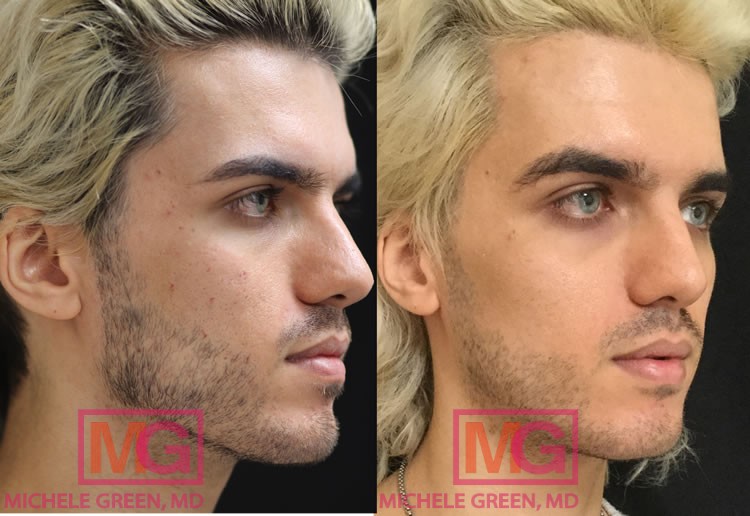
FAQs about ice-pick scar treatment
Are ice-pick scars or large pores?
Ice-pick scars are not the same as large pores. Pores are normal structures in the skin that either contain hair follicles or secrete sebum or sweat. For some patients, pores can become enlarged and noticeable, often appearing as small openings in the skin. Some individuals are genetically predisposed to having larger pores, while others develop them due to increased skin laxity or heightened sebum production. Ice-pick scars are indentations caused by insufficient collagen produced during the healing of an inflammatory acne lesion. These scars can be characterized by a deep, narrow, V-shaped depression that resembles puncture marks from an ice pick. Since ice-pick scars and large pores can appear similar, it is advisable to consult with a board-certified dermatologist like Dr. Green for evaluation.
What are other types of acne scars?
Ice-pick scars fall into the category of atrophic scars or depressions or indents in the skin’s surface that result from an underproduction of collagen during the wound healing process. Other types of atrophic scars include boxcar scars and rolling acne scars. Boxcar scars are wide, with round holes and sharp edges, while rolling scars are wavy and shallow, with sloping edges.
The second overarching type of acne scar is the hypertrophic acne scar, which forms raised scar tissue due to an overproduction of new collagen during the wound-healing process. Hypertrophic or keloid scars often look like lumpy skin growths and can grow bigger than the original lesion or wound.
Acne lesions can also result in post-inflammatory hyperpigmentation, or discoloration, on the skin’s surface, making the scar tissue appear red or dark. Hyperpigmentation occurs when the inflammatory acne infection triggers the melanocytes to produce an excess of melanin, the pigment in the skin. Post-inflammatory hyperpigmentation is not true acne scarring and does have the potential to resolve on its own eventually; however, it can take a significant amount of time to resolve independently without cosmetic intervention.
How can I avoid ice-pick acne scars?
The best way to prevent ice-pick acne scars is by treating and addressing acne breakouts as soon as they arise. Acne lesions such as cysts and nodules are the most likely to result in scarring due to the intensity of the associated inflammation. If left untreated, this inflammation can cause lasting damage to the skin, leading to acne scars that are often more difficult to treat than the original breakouts themselves. Furthermore, acne lesions should never be picked, squeezed, or popped, as this can spread the infection and heighten the risk of scarring. It is crucial to consult with Dr. Green as soon as an acne breakout occurs. Dr. Green provides a range of acne treatments in her private Upper East Side dermatology office, including topical and oral prescriptions and in-office procedures aimed at eliminating acne breakouts and preventing any risk of acne scar formation.
How do you flatten ice-pick scars?
The best way to treat ice-pick scars is through in-office procedures with a board-certified dermatologist like Dr. Green. Ice-pick scars are among the most challenging types of acne scars to address due to their deep, narrow nature. Treatments such as laser resurfacing, microneedling, subcision with dermal fillers, and chemical peels utilize different methods to flatten and improve these scars effectively. Lasers like Fraxel and eMatrix, along with traditional and radiofrequency microneedling techniques, stimulate collagen production in the dermis, resulting in smoother skin texture. Subcision helps to break apart the scar tissue beneath the skin, allowing for the production of new, healthy collagen and enabling dermal fillers to restore lost volume in the area. Chemical peels gently exfoliate the skin while promoting collagen production for a more even skin texture and tone. In more severe cases, punch excision may be suggested to remove the scar completely. No single treatment is inherently superior, and the most suitable option for flattening your specific ice-pick and acne scars will depend on your unique skin type, tone, and scar characteristics. During your consultation with Dr. Green, she will evaluate your skin and cosmetic objectives to develop a treatment plan that will help you achieve clear, radiant skin that lasts.
How much does ice-pick acne scar treatment cost?
The cost of ice-pick acne scar treatment depends on various factors, such as the type of treatment, the number of sessions needed, your geographic location, and the expertise of your provider. While treatments might be less expensive at a MedSpa, it is essential to have procedures performed by a board-certified dermatologist to ensure they are safe and effective for your skin type and tone. Using the wrong treatment, incorrect settings, or improper techniques can lead to adverse side effects like scarring or hyperpigmentation. To ensure the best cosmetic outcomes from your ice-pick acne scar treatment, consult board-certified dermatologist Dr. Michele Green today. She will first evaluate your medical history, skin concerns, and aesthetic goals to create a customized treatment plan tailored to your specific acne scars. Her office can then provide you with an estimate for the cost of the ice-pick acne scar treatment.
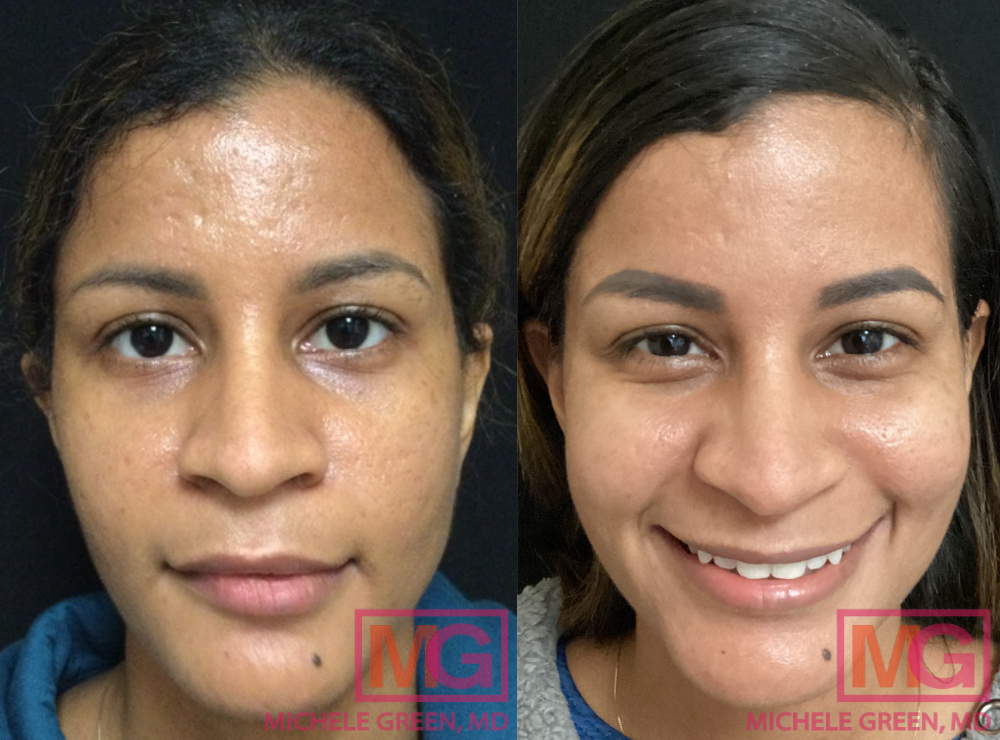
Can salicylic acid remove ice-pick scars?
Salicylic acid is a beta hydroxy acid that gently exfoliates the skin, removing dead skin cells, excess oils, and other impurities from the pores. It can also reduce inflammation and enhance skin texture and tone. Salicylic acid is available over the counter in various cleansers, pads, creams, and chemical peels. While salicylic acid can contribute to a smoother complexion, it typically does not target deep acne scars, such as ice-pick scars, on its own. It can be used alongside other active topicals and in-office treatments for the best cosmetic results.
Is retinol good for ice-pick scars?
Yes! Retinol is an excellent addition to a skincare regimen for reducing the appearance of ice-pick scars. Derived from vitamin A, retinol accelerates skin cell turnover, promoting the production of healthy new skin cells. It also stimulates collagen production, contributing to a more even and smooth skin texture. Retinols are not prescription-strength and can be found over the counter. Dr. Green’s Essential Antioxidant Infusion from her proprietary MGSKINLABs skincare line is an excellent retinol for softening ice-pick scars. This serum works to exfoliate the skin and increase collagen production. Its formulation also contains essential vitamins and nutrients to replenish the skin overnight. Patients with very deep ice-pick scars may benefit from tretinoin, a retinoid that is available only through a prescription from a board-certified dermatologist. Since retinol and retinoids increase skin photosensitivity, it is essential to practice proper sun protection by wearing a broad-spectrum sunscreen with a minimum SPF of 50 daily. While retinol and retinoids can significantly enhance skin texture and boost collagen production, patients with deep ice-pick scars will often require additional in-office treatments to diminish the appearance of their scars fully.
How to remove ice-pick scars naturally
Unfortunately, ice-pick scars tend to be permanent when not treated by a dermatologist and, therefore, will not go away naturally or on their own. For patients who would prefer to reduce the appearance of acne scarring at home, topical ointments can be good for mild scarring, particularly scarring that has caused discoloration or post-inflammatory hyperpigmentation. For icepick scars, which tend to be deep, narrow craters on the skin, it is best to consult with Dr. Green on the best treatment method, such as chemical peels, laser resurfacing treatments, traditional or radiofrequency microneedling, or punch excision.
How do you cover up ice-pick acne scars?
Many patients want to know how to conceal their ice-pick acne scars while undergoing treatment. Makeup can be a great way to create a smooth skin texture and minimize the appearance of acne scars. The most effective method to cover an ice-pick acne scar is to use a smoothing primer before applying any makeup. A primer can fill in the narrow indentations of the ice-pick scars, allowing your foundation and concealer to be applied seamlessly afterward. Depending on the severity of your ice-pick scars, one or more layers of primer may be necessary for optimal cosmetic results. It is crucial to thoroughly cleanse the skin and remove all makeup from the face to ensure that the pores do not clog and that no acne breakout occurs.
How do I get started with ice-pick acne scar treatment options today?
Icepick acne scars are deep, narrow indentations that develop when inflammatory acne causes irreversible damage to the underlying skin tissue. These scars can often be mistaken for enlarged pores and may induce feelings of self-consciousness about one’s appearance. Fortunately, numerous non-invasive acne scar treatment options are available at Dr. Michele Green’s private dermatology office on Manhattan’s Upper East Side, including laser resurfacing, TCA cross, chemical peels, traditional and radiofrequency microneedling, and punch excision. With such a range of treatment choices available, it can be challenging to determine the right combination for your specific skin concerns. An experienced board-certified dermatologist like Dr. Green will choose the best treatment options based on your skin type, skin tone, and severity of your acne scars, helping you achieve a smooth, healthy, and clear complexion that lasts.
Dr. Michele Green in NYC is an internationally renowned, board-certified cosmetic dermatologist with over two and a half decades of experience providing discerning individuals from around the globe with the best non-invasive treatment options available, particularly for ice-pick acne scars. Castle Connolly, New York Magazine, Super Doctors, and The New York Times consistently recognize Dr. Green as one of New York’s top dermatologists due to her dedication to patients and her expertise. Dr. Green employs a holistic approach to treating acne scars, tailoring each treatment plan to accommodate the patient’s skin type, skin tone, types of acne scars present, and unique aesthetic goals. When you consult with Dr. Green at her private dermatology office in the Upper East Side of Manhattan, she will collaborate with you to develop a personalized acne scar treatment plan that results in a smooth, clear, and beautiful complexion that lasts. To begin your ice-pick acne scar treatment and schedule a consultation with Dr. Green, call her NYC office at 212-535-3088 or contact us online today.
 212-535-3088
212-535-3088